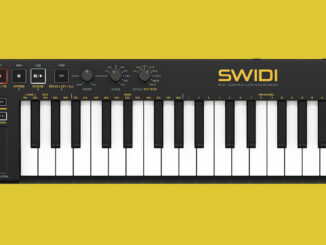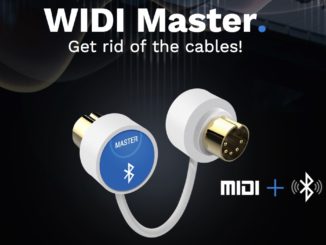CME iWA (instant wireless audio technology) is a new tech that promises near-zero latency using wireless audio.
When you make electronic music, there are always a lot of cables involved. Audio and MIDI cables, power supplies… it quickly becomes messy. Thanks to Bluetooth technology advanced in the past years, and so you can already play wirelessly with a MIDI keyboard. There is latency, but it’s not as noticeable as it used to be.
The Chinese company CME has done this successfully with the tiny WIDI adapters. Now they are going one step further and want to make audio smarter and wireless with the iWA technology.
CME iWA
The people behind the WIDI MIDI adapters have now introduced its innovative iWA (Instant Wireless Audio) technology. They promise that it will be a revolutionary solution that sets a new standard for wireless audio transmission for musicians, with high immunity to interference and near-zero latency.
iWA technology is designed with musicians in mind, says CME. It offers wireless HD audio in stereo using an extremely wide bandwidth. More it is highly immune to interface say the developers. It introduces a groundbreaking nano-second pulse transmission technology that completely removes the existing challenges with overcrowded frequencies
CME achieved in the latest tests to reduce the over-the-air latency to an impressive 1ms. If this is implemented in a product like the WIDI adapters, it will certainly be forward-looking.
And they also say that no software codecs and other compression technology are needed. “With enough space for correction on-the-fly: what goes in, simply goes out!”
“As the developers of WIDI, we understand that Bluetooth technology cannot fully meet the needs of all musicians when it comes to transmitting audio.” said Zhao Yitian, CEO at CME. “This realisation has inspired us to rise to the challenge and continue to innovate. In the end, we decided to take this risk and work with the community to develop iWA technology from scratch.”
CME’s IWA wireless audio technology has vast potential across a wide range of applications, including headphones, studio monitors and TX/RX solutions. Initially, the focus is on providing a solution for near-field scenarios where immediate response is required, such as in the studio and during rehearsals
First Impression
Audio over wireless is the future and that can be an important step forward in the right direction. Since the whole thing is still in development and not a finished product, it remains to be seen what CME will do with the technology. I think it’s great that a company is working on it
More information here: CME
WIDI is available at my partners



 CME WIDI Master
CME WIDI Master





Anyone have any experience with these devices. As simple as plugging it into my laptop and linking my op-1 field to the bluetooth midi and im all set or is it more convoluted than it needs to be or connection issues like most bluetooth devices?
I have a couple of Widi Jacks which I bought 1 or 2 years ago to try them out.
The iOS app (no experience with Android) is horrible, firmware upgrades break things more than fixing stuff.
When I have connection I experience midi drop-outs. Especially when doing note heavy sequences and arps.
That were my experiences with the Widi Jack. Don’t know if things have improved lately but I reverted back to trusty midi cables.
WIDI devices pair automatically with other Bluetooth MIDI controllers and WIDI devices. Pairing wth an OP-1 field and creating a 1-to-1 connection should be relatively simple.
You can check out the online start guide via https://www.cme-pro.com/widi-bud-pro-start-guide-bluetooth-midi-dongle/
And opt-in on the shared knowledge of the community via http://www.facebook.com/groups/cmeprofans
Hope this helps 👍
I only have experience with the WIDI Master, but basically, You plug a set into one device, plug another set into another device, they will pair together and that’s a wrap. The key is, only the OUT is powered. So, on a device where you need IN, you will need to have it coupled to an OUT. Also, make sure no other WIDI Masters are active when you try to pair a set.
BTW: I have HIGH hopes for iWA. My 20 ft headphone cable is a constant source of pain and suffering. 🙁
Great to hear this 😁 If you have multiple WIDI devices, you can use WIDI App to create fixed pairs and groups (merge, splits). This will allow automated connections as you configure it: https://www.cme-pro.com/widi-master-start-guide-bluetooth-midi/#tve-jump-1834add1fd2
For your reference, WIDI Master is powered via the MIDI out of your device. If your device does not deliver this phantom-like power, or only has a MIDI in, you can use WIDI Jack as it has an external power option for its USB-C (no data) port: https://www.cme-pro.com/widi-which-device-will-you-connect/
😉
I have been using a pair of WIDI uHost without any issues. Setup using the Android app for setup and firmware upgrades, it’s all pretty straightforward. All I had to do is to set one as a slave.
I also have other BLE MIDI devices and they all connect flawlessly. I’m using a Linnstrument with the slave uHost and the massive MIDI data can be too much for it, but that was solved using configs in both uHost and Linnstrument.
If the iWA devices are just as robust, I’m excited to use them for monitoring while playing.
Great article and thanks for sharing. Please allow me to clarify two things. CME is a Singapore-based company with a completely remote team. I am from The Netherlands, and our development team is based in France.
Also, iWA technology is, unlike WIDI, NOT utilising Bluetooth technology. It implements a totally different pulse (instead of your traditional radiowaves) technology and operates outside the 2.4 GHz frequencies.
That is how it is immune for interference and differentiatea itself from Bluetooth, Wi-Fi and other wireless audio solutions.